Collectibles: Many Gems at Swann's Winter Auction of Ski Posters
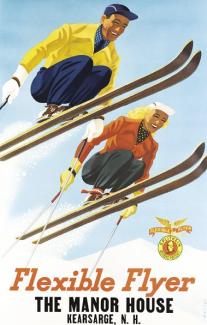
The highest price paid for a vintage find: $17,500.
Manhattan’s Swann Galleries offered a mix of classic and unusual American posters at its February 2022 vintage sale, along with a handful of blue-chip European ski posters that commanded high prices. The 45 posters, from countries as diverse as France, Austria, Switzerland, Poland, the former Czechoslovakia and the United States, were the amalgam of artistic rarities, masterpieces and oddities that collectors have come to expect from this well-regarded auction house.
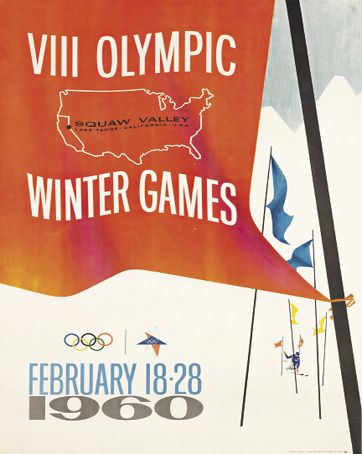
known, so this 1959 poster pin-
pointed it on a map.
Among the American pieces was artist Jack Galliano’s “VIII Olympic Winter Games/Squaw Valley, Feb 18–28, 1960.” This was the second of two official posters designed for the Squaw Valley Winter Games (the first one had been issued before the exact dates of the Games were determined). It was printed in late 1959, and a map of the U.S. on the flag shows the location of Squaw Valley. With an estimated worth of between $1,200 and $1,800, the poster sold for $812 (including the buyer’s premium, which is 25 percent of the hammer price).
A “Ski Alta” poster from about 1941 depicted the Alta Lodge, with a block of advertising text promoting the Alf Engen Ski School and the resort’s location “Just above Salt Lake City.” “I stayed here when I was younger,” recalls Nicholas Lowry, president of Swann, head of the gallery’s poster division and an appraiser on PBS’s Antiques Roadshow. “We’ve had this poster several times before. It’s not incredibly rare, but it’s rare enough. If you look closely, you can see that there’s a pasted tip-on that says ‘Alf Engen,’ who took
over the ski school in 1949. We did some research and found that his name was covering ‘Durrance,’ as in Dick Durrance, who led Alta’s ski school from 1940–1942. It was clearly cheaper to paste Engen’s name over Durrance’s and keep using this original poster.” The poster sold for $3,250, higher than its $3,000 estimate.
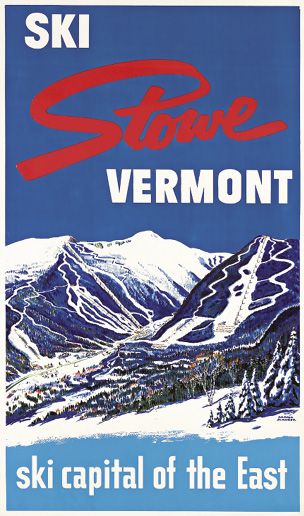
between 1954 and 1960.
Two ski posters in the auction were created by the German-born designer Sascha Maurer, best known for his work for the New Haven Railroad, New England ski resorts and ski manufacturers. They included Maurer’s “Ski Stowe Vermont/ Ski Capital of the East,” late 1950s. “Maurer designed the Stowe logo, the swoosh ‘S,’” says Lowry. “This is wonderful, but I don’t believe this was its first appearance of the logo.” The poster was estimated between $1,500 and $2,000, and realized $1,188.
The second Maurer poster advertised Flexible Flyer skis (top of page) and had been overprinted for The Manor House in Kearsarge, New Hampshire. Estimated between $2,000 and $3,000, it sold for $1,690. “They printed a lot of posters in this fashion, leaving a blank space on the lower part of the poster for the name of the distributor or hotel,” Lowry says. “Just look at this happy couple, jumping together, their form is great. It’s so joyful—it’s one of his best posters. In fact, it’s a perfect ski poster.”
Another New England ski classic, “New Hampshire,” depicted an iconic image: a faceless skier and an enormous snowflake floating over a map of the state. It was the 1935 creation of Edgar Hayes “Ted” Hunter Jr., who skied in the 1936 Olympics in Garmisch-Partenkirchen and trained as an architect—at Dartmouth College and later at Harvard University—under Bauhaus master Walter Gropius. Hunter went on to become a notable designer of midcentury modern houses. Estimated between $600 and $900, the poster sold for $688.

An artist named D. Thayer was the creator of “Sugarloaf,” a circa-1955 poster for Maine’s largest ski mountain. The resort opened in 1953, and Lowry says that “I researched when the third chairlift went in, which is how I dated this poster. The artist gave us some telltale hints. When they draw something so specific as each chairlift, you know they’re working from either a photograph or real life. I’ve also never seen this poster before.” The sale price of $875 was below the top $1,000 estimate.
Sun Valley images are typically big sellers at Swann’s auctions. This sale included “Sun Valley/Round House on Baldy Mountain,” arguably the most famous of the bunch. The 1940 creation by Dwight Clark Shepler had a blank space at the bottom for a railroad company to leave its imprint. The $2,860 final price was just shy of the $3,000 top estimate.
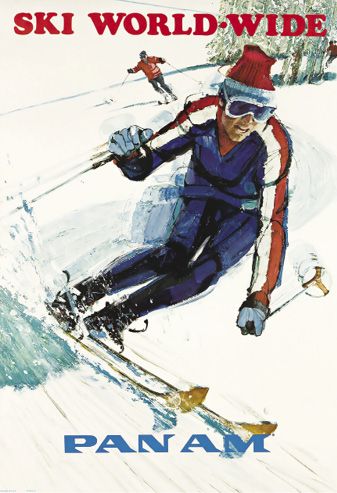
influence of Downhill Racer.
“Ski World-Wide/Pan Am” dates from 1970 and shows a downhiller in full racing form. It can’t be a coincidence that the racer looks like Robert Redford, whose film Downhill Racer had premiered the year before. “I like the fact that it’s done in a cinematic way, with the repeating images of his poles and legs, so that it appears that he’s in motion and going very fast,” Lowry says.
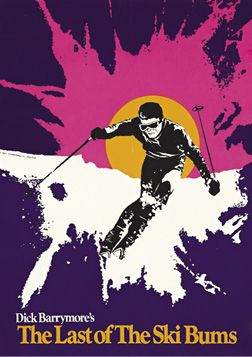
for 1969.
Bidders liked it, too, driving the price way above the $1,200 top estimate to sell for $2,600. Speaking of ski films, a poster for Dick Barrymore’s The Last of the Ski Bums from 1969, with its Day-Glo colors characteristic of the era, jumped its top estimate of $600 and sold for $812.
One of the most unusual offerings at the sale, “Ski the Black Hills/South Dakota,” was created by an unknown designer from the late 1960s. Lowry guessed that the mountain depicted was Terry Peak, given its claim as the “Highest Ski Area East of the Rockies.” Mount Rushmore, also depicted, actually lies 36 miles to the south of Terry, as the crow flies. “It’s psychedelic in style, with that typography, the colors and even the skier’s sweater,” says Lowry. “It’s very groovy and the most unusual ski poster in the sale.” When it sold for $292, well below its low estimate of $400, it also proved a bargain.
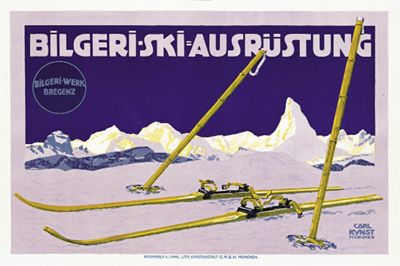
sold Bilgeri bindings.
When the auction turned to European ski posters, many far older than their American counterparts, the bidding was more fevered, often with higher prices as a result.
One of the great classics, “À Chamonix–Mont Blanc,” with a high-flying ski jumper, was one of five official posters for the 1924 Olympics in Chamonix published by the PLM Railway. Note that the event was designated an Olympics only after the fact. All of them were issued with text variants, sometimes promoting the Games and later on winter activities in the area itself. This version is dated 1927, repurposed to advertise Chamonix’s winter sports facilities. With an estimate of $3,000 to $4,000, it sold for $3,750.
“Bilgeri-Ski Ausrüstung” is an iconic image of ski poles, leather baskets and wooden skis with the then-new Bilgeri bindings. It readily appeals to collectors who seek posters of vintage ski equipment. The fact that artist Carl Kunz posed the gear against the Matterhorn doesn’t hurt, either. Even more striking about this image is the purple sky, with a

the Eiger and Jungfrau.
purplish cast on the snow. “I said, ‘Purple snow? Purple sky?’ when I first saw this poster years ago,” Lowry remembers, “but an artist friend has assured me that purple is the color that she and many others see at certain times of day in the Alps.”
One of the most astonishing images at the auction was a poster for Swiss ski resort Mürren from 1931, showing a skier plunging headlong down a piste with what appears to be the Eiger, Mönch and Jungfrau rearing up behind him. This eerie, dreamlike image by artist André Lecomte is “like an airbrush masterpiece—you’ve got the blur of the sky, the Alpine purple again between two flags and the mountains in the background,” Lowry says. “The text is also masterfully done.” Bidders appeared equally intrigued, and the $6,000 high estimate was easily surpassed, with the final sale price at $10,000.
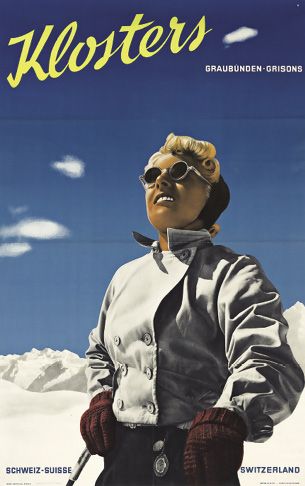
photo in 1943.
“Klosters,” by photographer Andreas Pedrett, is “less of an accomplished photomontage and looks more like a colorized photograph,” says Lowry. The poster sold for $4,000, more than three times its top estimate. “It’s very unusual, and what she’s wearing is phenomenal ski fashion,” Lowry adds.
Another photomontage was Emil Schulthess’ 1937 poster for Pontresina. A black-and-white photographic background of skiers heading down the treeless pistes of Diavolezza is superimposed with a free-floating pair of glacier glasses and the reflections of a woman’s face. “I love it just because you get these reflections on glasses, which is odd because the glasses aren’t on somebody’s face,” Lowry observes. “These mysterious floating glasses reflect the image of a happy, smiling skier. It’s unbridled joy and happiness, and we all know that feeling on the mountain.”
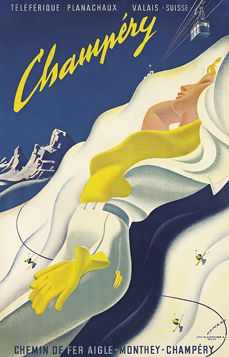
Pekert's sensual skier.
The clear star of the auction: Martin Peikert’s deeply sensual poster for Champéry. This surreal fantasy from 1955 depicts a giant sleeping female skier, her curvaceous shape matching the bumps of the piste, as a tram whizzes overhead and diminutive skiers schuss beside her.
“Peikert has developed a cult following among collectors,” Lowry says. “Even his less good images sell for more than people expect. This happens to be one of his best images, the anthropomorphization of the mountain. The colors are great, the conceit is good, and the execution is fantastic. We expect it to go high for all those reasons,” he adds. Indeed it did, flying past its $10,000 top estimate and selling for $17,500.
Swann’s next auction of vintage ski posters will take place in February 2023. Visit swanngalleries.com. 
